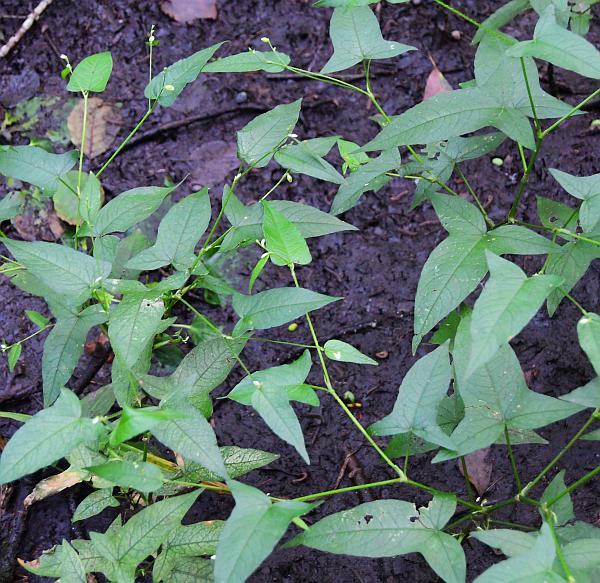Persicaria arifolia (L.) Haraldson
Halberd-Leaved Tear-Thumb

Native
CC = 10
CW = -5
MOC = 2
SRank = S1
© SRTurner
Persicaria arifolia (L.) HaraldsonHalberd-Leaved Tear-Thumb | |
 |
Native CC = 10 CW = -5 MOC = 2 SRank = S1 |
© SRTurner |
|
Family - Polygonaceae Habit - Taprooted annual forb, sometimes rooting at lower nodes. Stems - Spreading or climbing, to 1.5 m, glabrous, but armed with small, downward-curved (hooked) prickles. Ocreae persistent or disintegrating with age, 8-15 mm long, cylindric, tan or brownish, papery, with minute prickles at the base, the margin with erect bristles 0.5-2.5 mm, the surface glabrous or appressed- to spreading-hairy.
Leaves - Alternate, simple, petiolate. Petioles 1-7 cm long. Leaf blades 6.5-20.0 cm long, 6-16 cm wide, triangular to halberd-shaped, usually with a pair of spreading, sharply pointed, basal lobes, truncate to shallowly cordate at the base, tapered to a usually sharply pointed tip, the margins otherwise entire, but hairy and/or prickly, the upper surface appressed-hairy or rarely glabrous, the undersurface stellate-hairy or rarely glabrous, sometimes minutely prickly along the main veins, lacking impressed glands, lacking a reddish or purplish area on the upper surface.
Inflorescence - Terminal and axillary, solitary or grouped into small panicles, 0.5-1.2 cm long, 3-8 mm wide, dense and headlike, uninterrupted, the stalk 1-8 cm long, stellate-hairy and reddish or pinkish glandular-hairy toward the tip, prickly toward the base. Ocreolae usually overlapping except sometimes toward the axis base, the margins smooth or with bristles to 0.5 mm long, not gland-dotted.
Flowers - Flowers 2-4 per fascicle, the perianth pink or red, often whitish green toward the base, bell-shaped, not gland-dotted, the tepals 4, 5-6 mm long, fused below the midpoint, the nerves not prominent, not anchor-shaped. Stamens 8, not exserted, the anthers pink. Styles 2, distinct to the base, not exserted, not persistent.
Fruits - Fruits 3.5-6.0 mm long, 3-4 mm wide, not exserted, bluntly 2-angled, beakless, the faces convex, the surface smooth, dark brown to black, shiny. Flowering - July - October. Habitat - Bottomland forests, acid seeps, wet sandy ground near spring branches, often partially submerged. Origin - Native to the U.S. Lookalikes - P. sagittata. Other info. - This species is rare in Missouri, currently known from only two counties in the southeast portion of the state. It is more common in the New England states and parts of the upper Midwest. Missouri is near the far southwestern extent of the plant's natural range. The species is very easy to identify from its square, prickly stems, hastate leaves, and small white inflorescences. Habitat is also a prime characteristic to use for ID, as this plant is usually found in wet areas with acidic substrate. It could be mistaken for the closely related P. sagittata, but the two are easily distinguished by the shape of their respective leaf bases. P. sagittata leaves are deeply cordate with the basal lobes extending backwards. Photographs taken in Brown Summit, NC., 9-8-02 (DETenaglia); also at Holly Ridge Conservation Area, Stoddard County, MO, 8-16-2021 (SRTurner). |